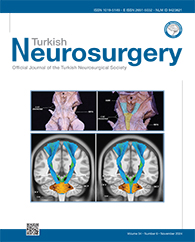2Bakirkoy Dr. Sadi Konuk Training and Research Hospital, Department of Neurosurgery, Istanbul, Türkiye
3Acibadem Taksim Hospital, Department of Neurosurgery, Istanbul, Türkiye DOI : 10.5137/1019-5149.JTN.44988-23.3 AIM: To compare the treatment outcomes of surgical and endovascular methods in patients with intracranial aneurysms.
MATERIAL and METHODS: A total of 1183 patients [722 (61%)] female and 461 [(39%) male] with intracranial aneurysms, including 615 with subarachnoid hemorrhage (SAH) and 568 without hemorrhage, were retrospectively reviewed.
RESULTS: The mean age of patients was 51.3 ± 12.4 years. Male patients were significantly more likely to have aneurysmal hemorrhage at admission (p<0.001). Surgical intervention was performed in 462 (39.1%) patients, and endovascular methods were used in 541 (45.7%) patients. Sixty-five (5.5%) patients were treated with both methods. The World Federation of Neurosurgical Societies grade was found to have a strong negative effect on the Glasgow Outcome Scale (GOS) score (Wald = 21.81). The GOS scores were significantly higher in the surgical treatment group than in the endovascular treatment group for aneurysms in the anterior communicating artery. Based on follow-up digital subtraction angiography, the complete occlusion rate of the aneurysm was significantly higher with the surgical method than with the endovascular method (p<0.001). The complete closure rate of aneurysms following endovascular treatment was significantly lower than that after surgical treatment (p<0.001). However, we found no significant difference between the two methods in terms of residual aneurysms requiring reintervention.
CONCLUSION: Treatment of intracranial aneurysms should be decided jointly by an experienced team of neurovascular surgeons, neuroradiologists, and anesthesiologists.
Keywords : Endovascular intervention, Intracranial aneurysm, Neurovascular surgery, Subarachnoid hemorrhage




